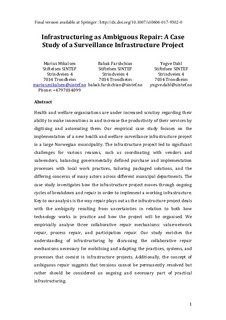Infrastructuring as ambiguous repair: a case study of a surveillance infrastructure project
Journal article, Peer reviewed
Accepted version
Permanent lenke
http://hdl.handle.net/11250/2479902Utgivelsesdato
2017Metadata
Vis full innførselSamlinger
Originalversjon
Computer Supported Cooperative Work (CSCW). 2017, Published ahead of print . 10.1007/s10606-017-9302-0Sammendrag
Health and welfare organisations are under increased scrutiny regarding their ability to make innovations in and increase the productivity of their services by digitising and automating them. Our empirical case study focuses on the implementation of a new health and welfare surveillance infrastructure project in a large Norwegian municipality. The infrastructure project led to significant challenges for various reasons, such as coordinating with vendors and subvendors, balancing governmentally defined purchase and implementation processes with local work practices, tailoring packaged solutions, and the differing concerns of many actors across different municipal departments. moves through ongoing cycles project moves through ongoing cycles of breakdown and repair in order to implement a working infrastructure. Key to our analysis is the way repair plays out as the infrastructure project deals with the ambiguity resulting from uncertainties in relation to both how technology works in practice and how the project will be organised. We empirically analyse three collaborative repair mechanisms: value-network repair, process repair, and participation repair. Our study enriches the understanding of infrastructuring by discussing the collaborative repair mechanisms necessary for mobilising and adapting the practices, systems, and processes that coexist in infrastructure projects. Additionally, the concept of ambiguous repair suggests that tensions cannot be permanently resolved but rather should be considered an ongoing and necessary part of practical infrastructuring.
